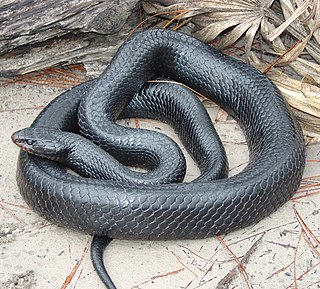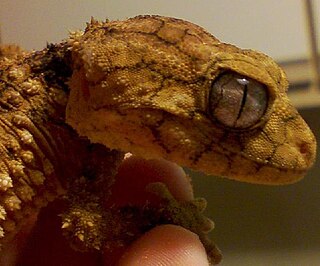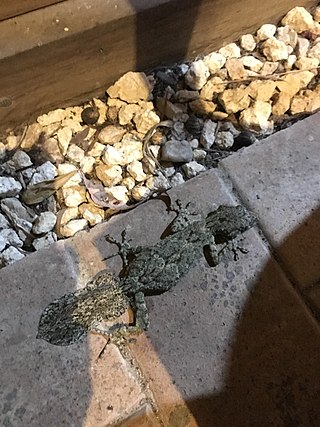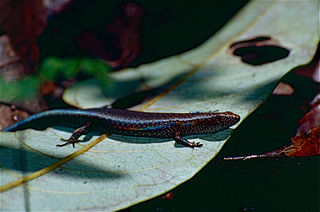Related Research Articles

Lampropholis is a genus of skinks, commonly known as sunskinks, in the lizard subfamily Eugongylinae of the family Scincidae. The genus Lampropholis was previously found to belong to a clade with the genera Niveoscincus, Leiolopisma and others of the Eugongylus group within Lygosominae. All species of Lampropholis are endemic to Australia. For similar skinks see genera Bassiana, Pseudemoia, and Niveoscincus.

Edward Pierson RamsayFRSE FLS LLD was an Australian zoologist who specialised in ornithology.

The eastern indigo snake is a species of large, non-venomous snake in the family Colubridae. Native to the southeastern United States, it is the longest native snake species in the country.

Edgar Ravenswood Waite was a British/Australian zoologist, ichthyologist, herpetologist, and ornithologist.
Harold George "Hal" Cogger is an Australian herpetologist. He was curator of reptiles and amphibians at the Australian Museum from 1960 to 1975, and Deputy Director of the museum from 1976 to 1995. He has written extensively on Australian herpetology, and was the first author to create a field guide for all Australian frogs and reptiles.
Dr. Glen Milton Storr was an Australian ornithologist and herpetologist. He joined the Western Australian Museum in 1962 and became curator of ornithology and herpetology in 1965. He was a member of the Royal Australasian Ornithologists Union (RAOU), and served as secretary of the Western Australian Branch of the RAOU in 1954.
Allan's lerista, also known commonly as Allan's skink and the greater robust fine-lined slider, is a species of skink, a lizard in the family Scincidae. This rare species is endemic to Queensland, Australia.

Nephrurus amyae, also known commonly as the Centralian rough knob-tail gecko, is a species of lizard in the family Carphodactylidae. It is the largest gecko in the genus Nephrurus, and like all species of Nephrurus is endemic to Australia.

Jeanette Adelaide Covacevich (1945–2015) was a herpetologist in Queensland, Australia. As a senior curator of vertebrates at the Queensland Museum, she discovered and studied many reptiles and frogs in Queensland. Covacevich is most famous for rediscovering and describing the Inland Taipan snake, the world's most venomous snake. In addition, she described over thirty new species and genera including the Cape York striped blind snake, the Nangur spiny skink, and the Bulburin leaf-tailed gecko.
Saltuarius kateae, also known commonly as Kate's leaf-tailed gecko or the Mount Marsh leaf-tailed gecko is a species of gecko, a lizard in the family Carphodactylidae. The species is native to New South Wales.

Saltuarius moritzi, also known commonly as the New England leaf-tailed gecko or Moritz's leaf-tailed gecko, is a species of lizard in the family Carphodactylidae. The species is native to Australia.
Lampropholis adonis, also known commonly as the diamond shielded sunskink and Ingram's litter skink, is a species of skink, a lizard in the family Scincidae. The species is endemic to Queensland in Australia.
Lampropholis caligula, also known commonly as the montane sunskink or the montane sun skink, is a species of lizard in the family Scincidae. The species is endemic to New South Wales in Australia.

Lampropholis coggeri, also known commonly as the northern sun skink and the rainforest sunskink, is a species of lizard in the family Scincidae. The species is endemic to Queensland in Australia.

Lampropholis couperi, commonly known as the plain-backed sunskink, is a species of skink, a lizard in the family Scincidae. The species is endemic to Queensland, Australia.
The saxicoline sunskink is a species of skink, a lizard in the family Scincidae. The species is endemic to Queensland in Australia.

Saproscincus challengeri, also known commonly as the Border Ranges shadeskink, Challenger's skink, the challenging shade skink, and the orange-tailed shadeskink, is a species of lizard in the family Scincidae. The species is native to New South Wales and Queensland in Australia.

Saproscincus czechurai, also known commonly as Czechura's litter-skink, Czechura's skink, and the wedge-snouted shadeskink, is a species of lizard in the family Scincidae. The species is endemic to Queensland in Australia.
Saproscincus hannahae, also known commonly as Hannah's shadeskink and Hannah's shade-skink, is a species of lizard in the family Scincidae. The species is endemic to Queensland in Australia.
Lerista emmotti, also known commonly as the Noonbah robust slider, is a species of skink, a lizard in the family Scincidae. The species is endemic to Queensland in Australia.
References
- ↑ "Lampropholis couperi ". Reptile Database . Retrieved 1 August 2023.
- 1 2 "Patrick Couper biography". The Queensland Museum. Retrieved 13 November 2017.
- 1 2 Beolens, Bo; Watkins, Michael; Grayson, Michael (2011). The Eponym Dictionary of Reptiles. Baltimore: Johns Hopkins University Press. xiii + 296 pp. ISBN 978-1-4214-0135-5. (Couper, P., p. 60).